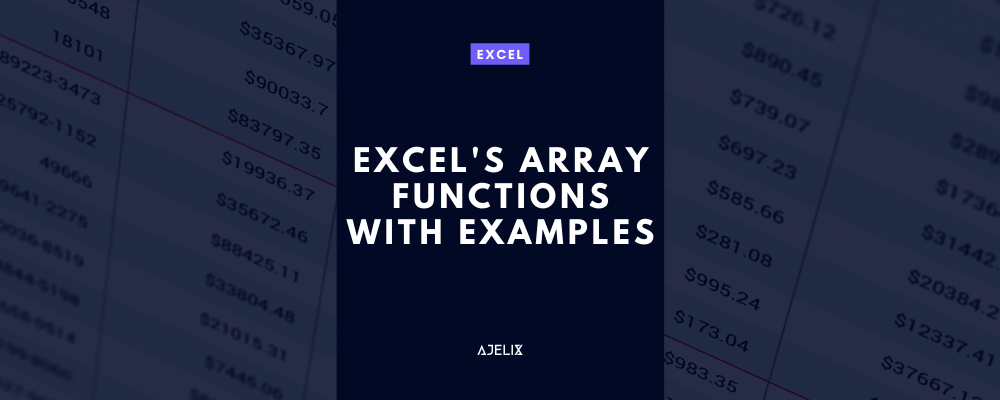Excel’s Array Functions with Examples

Excel is a powerful tool for data analysis and manipulation. One of Excel’s most powerful and least understood features is its array functions. Array functions are a set of functions that can quickly calculate complex calculations over multiple data sets. This article will introduce some of the most commonly used array functions, provide examples of how they are used, and discuss their advantages and limitations. If you’re searching for new more effective formulas you might find our excel formula and function library useful.
In Excel, an array is a group of cells that form a rectangular shape. Array functions allow users to quickly perform calculations on multiple arrays at once. For example, the SUMPRODUCT function can calculate the sum of two or more arrays, while the AVERAGE function can calculate the average of an array of numbers. You can use the AVERAGEIF function to calculate the average of an array if all of the data meets certain conditions.
Array Functions Forms
Array functions are used for a variety of purposes, including data analysis, forecasting, and statistical analysis. For example, the LINEST function can be used to fit a linear regression line to a set of data, allowing users to make predictions about future values. Use the FORECAST function to predict future values based on a given set of data.
Manage Large Data sets
The INDEX function can be used to extract data from a large array quickly. For example, to extract the value in cell A2 from the array A1:A5, the following formula would be:
=INDEX(A1:A5,2)
The MATCH function is a function that helps you manage large data sets and can find the position of a value in an array. For example, to find the position of the value “Apple” in the array A1:A5, the following formula would be:
=MATCH(“Apple”,A1:A5,0)
If you’re struggling with large datasets you might find useful Excel text functions that can help you manage your text data better with our blog article.
Summarize data
The SUMIFS function sum values that meet multiple criteria. For example, to sum the values in cells A1:A5 if they are greater than 5 and less than 10, the following formula would be:
=SUMIFS(A1:A5,”>5”,”<10”)
Use the SUMPRODUCT function to calculate the sum of two or more arrays. For example, to calculate the sum of the values in cells A1:A5 and B1:B5, the following formula would be:
=SUMPRODUCT(A1:A5,B1:B5)
The COUNTIFS function count cells that meet multiple criteria and the AVERAGEIFS function calculates the average of cells that meet multiple criteria.
Perform financial calculations with Array functions
Array functions can be used to perform financial calculations, such as the PV (Present Value) function which can be used to calculate the present value of a future cash flow.
The PV function calculates the present value of a future cash flow. For example, to calculate the present value of a $1000 cash flow occurring in 10 years, with an interest rate of 5%, the following formula would be:
=PV(5%,10,-1000)
The FV (Future Value) function calculates the future value of a present cash flow. The IPMT (Interest Payment) function calculates the interest payments on a loan.
Statistical analysis with array functions
The MINVERSE function calculates the inverse of a matrix. Calculate the inverse of the matrix A1:B2, here’s an example of how this formula would look:
=MINVERSE(A1:B2)
Another statistical function CORREL can calculate the correlation coefficient between two sets of data. For example:
=CORREL(F29:F50,E29:E50)
Conclusion
Array functions are powerful tools for data manipulation and analysis. Use these functions to extract data from large arrays and perform financial and statistical calculations.
In addition to the examples provided in this article, there are many other array functions available in Excel. We recommend practicing these functions with smaller, manageable data sets before attempting more complex calculations. With practice, these array functions can quickly and efficiently analyze large amounts of data.
Learn more about Excel and Google Sheets hacks in other articles. Stay connected with us on social media and receive more daily tips and updates.


